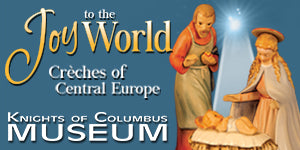The Sunday after Christmas, in the ballroom of the Annex YMA—which sometimes doubles as a bingo hall—a modest market was underway. People, mostly into life’s second half, shuffled from folding table to folding table, speaking in hushed tones about the things those tables held: curious little rectangles with pictures, words and numbers on them, once meant to be discarded, now meant to be preserved.
Small as they are, postage stamps, especially historically interesting ones, loom large for the members of the New Haven Philatelic Society, and for the people who attend its monthly fourth-Sunday shows. For Michael Frechette, president of the 101-year-old NHPS, stamps are miniature works of art. And like more full-sized art, these tiny ink-on-paper works are reflections of the lives and times that made them. Through stamp collecting, “You can learn a lot about any country or culture”—or, potentially, “about anything you can think of,” Frechette says.
Even granular inquiries can lead to grand revelations. In the NHPS’s current quest to collect postmarks from all 700 or so Connecticut post offices, both extant and defunct, Frechette unexpectedly learned about Ore Hill in the northwest town of Salisbury—the epicenter of Connecticut’s mid-18th-century “iron rush,” where compasses once wobbled erratically because of all the magnetic material underfoot.
sponsored by
While stamp collecting for Frechette is “a way to enjoy yourself, not make money,” there are those who’ve made stamps their business. Serious investors can and do make profits by investing in rare stamps and letting them appreciate. But like all marketplaces, the philatelic market has its booms and busts, surpluses and scarcities, grifts and black markets.
During WWII, immigrants and refugees fleeing Europe invested their possessions in highly valuable stamps they could easily smuggle into the U.S., and whose value they could in part recoup on New York City’s Nassau Street—the seat of the city’s “Stamp District.” Today, as then, scarcity and demand pushes the value of some stamps to unbelievable heights.
The Inverted Jenny is a 24-cent stamp issued by the U.S. in 1918, in which an image of the Curtiss JN-4 “Jenny” airplane flying across the center is printed upside down. A block of four Inverted Jennys, of which only 100 are known to exist, was sold at a Robert A. Siegel auction in 2005 for $2.7 million. Another example is the legendary Z Grill stamp—a U.S. one-center marked by a particularly rare “grill,” or indentation signaling that a stamp’s been used. Today, a Z Grill is valued at $3 million—or a 300 million-percent increase from its original face value, inflation notwithstanding.
Those stamps enjoy rarefied air, of course, representing an extremely small sliver of philatelic activity. Most stamps and stamp collections are worth less or little more than their original face value, and detecting truly rare finds takes years of accumulated expertise. While the potential for high rewards is real, the uneducated are easily duped.
Brian McGrath, NHPS’s resident auctioneer and show chairman, showed me the letter a man received after being taken in by a stamp investing scheme that dates to the 1970s. The letter documents how the man paid $200 to a rare stamp-buying syndicate, which promised to pay out appealingly high returns as the acquired stamps appreciated. He received $20 the first year, but when the syndicate “liquidated” the following year, the man received several sheets of supposedly rare stamps worth nothing more than a few dollars, McGrath estimates.
Even with crooks out of the picture, collecting stamps can be a tricky affair. A rare stamp isn’t necessarily a valuable stamp. Scarcity is an important factor, but if that scarcity doesn’t give rise to demand, even rare or one-of-a-kind stamps won’t bring in a haul. Condition, too, is a big driver of value for stamps. And while age seems like it should matter, given its correlation with scarcity, being aged is perhaps the biggest red herring in stamp-collecting.
McGrath recalls with an eye roll the calls he receives from people hoping to discover their father’s or grandfather’s old stamp collection is now worth a fortune. A common scenario, he says, involves Adolf Hitler stamps those fathers and grandfathers brought back from the war. The trouble is, a lot of G.I.s had the same idea, creating a surplus that waters down the price. McGrath, for his part, sells several of his Hitler-head stamps for 75 cents apiece.
But like Frechette said, collecting stamps doesn’t have to be about cashing in. Like those Hitler ones, many of the stamps at the last fourth Sunday show could be bought with the bills sitting in a typical wallet, or even the change sliding around the floor of a typical car. For the wealthy or the aspirational, there were also high-end dealers, like Ross Wiessmann, selling stamps worth upwards of $10,000.
As you can imagine, the ranks of the NHPS are mostly filled by an older generation—one that remembers collecting stamps from cigarette packs, comic books and Ivory Soap boxes. Frechette, now 66, began his collection at the age of 7. “It’s something you can do ’til the day you die,” he says. He knows that young people today, like his grandkids, are much more enthused by the digital novelties of their youth than the paper bits of his.
Maybe when they’re older?
New Haven Philatelic Society
Weekly Meetings: Tue 7:30-9:30pm @ 1205 Chapel St, New Haven (map)
Monthly Shows: 4th Sun 10am-3pm @ Annex YMA – 554 Woodward Ave, New Haven (map)
(203) 627-6874
www.nhps1914.org
Written and photographed by Daniel Shkolnik.









